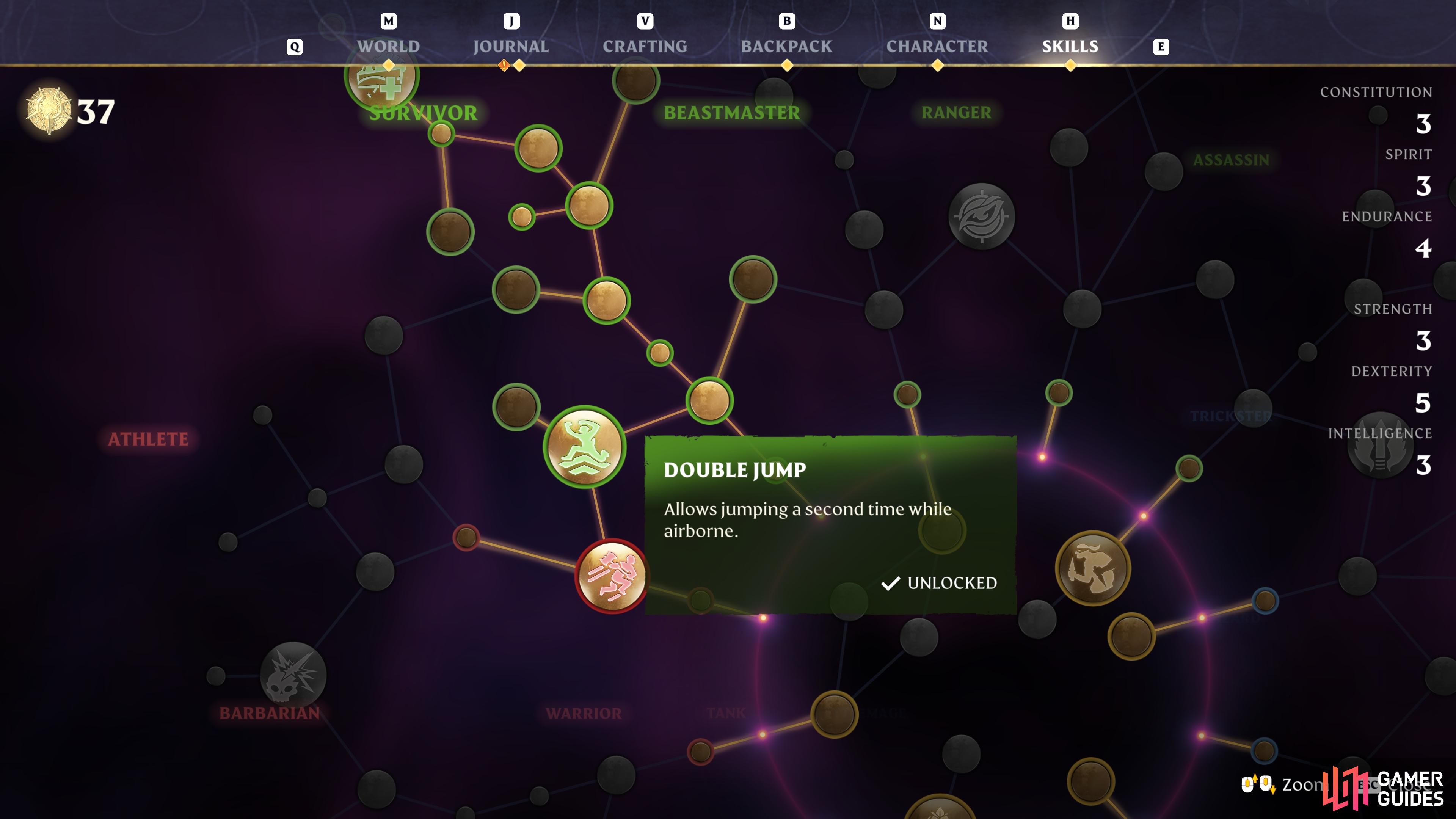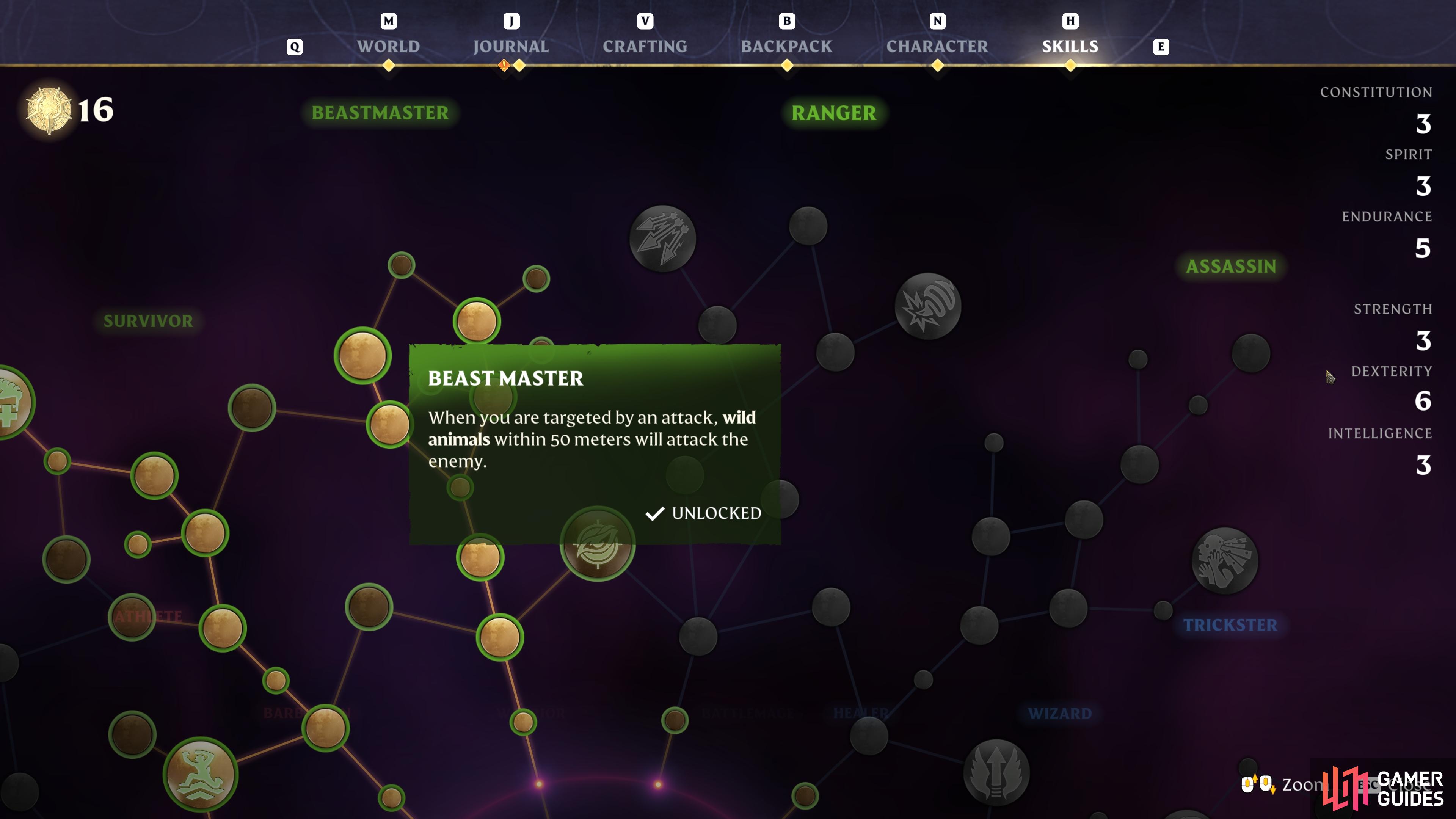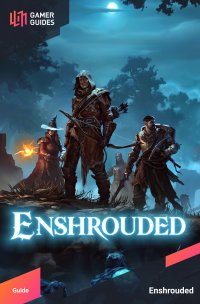The skill tree system in Enshrouded gives you a lot of options to customize your own build to fit a particular playstyle. There are 12 default skill trees by default, but you have the freedom to hybridize by investing in skills from any tree that you want. Most solo players will want a good balance of survivability and damage capacity to give them the best chances against the toughest foes in Embervale, but there are plenty of excellent utility skills that are easily overlooked, but which can greatly improve your gameplay experience. On this page, we’ll show you some of our favorite utility and survival skills in Enshrouded and explain why they’re so good to use with almost any build.
We show you some of the best utility and survivor skills in Enshrouded.
List of Survivor / Utility Skills in Enshrouded¶
The recommended skills listed below will take you through most of the survivor skill tree in a way that you can naturally progress through from the beginning of the game, but you may not want to invest in all of these at the same time before you commit to other, more specific combat-related skills first. See what takes your fancy, and incorporate it into your build as you wish!
Runner¶
The Runner skill can be easily overlooked in Enshrouded. You’ll find it as one of the first skills in the Survival tree, and all you need to do to get it is invest one point in an Endurance boost, then two points for Runner itself. The Runner skill not only increases your base sprinting speed by 10%, but it also decreases stamina consumption for all actions by 10%. This means that you’ll use less stamina not only when sprinting, but also when climbing, gliding, and mining or harvesting resources. As a result, you’ll get an overall improvement to your stamina consumption rate, which is particularly important in Enshrouded, where stamina is one of the most useful stats that you can invest in.
| Skill | Description |
|---|---|
| Runner | Sprinting speed increased by 10% and stamina consumption decreased by 10%. |
In terms of the direct impact of the Runner skill, you’ll notice that you can now outrun some of the faster enemies that you encounter, especially the tougher dual-wielding shroud enemies that can chase you for a long time within the shroud. You’ll also be able to more easily avoid attacks from ranged enemies, such as when they fire explosives which detonate in a circle on the ground. You have a limited amount of time to get out of these circles, so you can do it that much faster with the Runner skill.
Double Jump¶
The next useful utility skill in the Survivor tree that you should consider getting early on is Double Jump. You can get this immediately after Runner once you have 4 skill points to spend. It may not seem like the most relevant skill for some playstyles initially but trust us when we say that this one is absolutely essential if you want to successfully navigate some of the trickiest parts of dungeons, but also while adventuring in general. The double jump basically does what it says; provides you with an extra jump that you can execute as soon as you’ve used the first, so you can jump higher.
| Skill | Description |
|---|---|
| Double Jump | Allows jumping a second time while airborne. |
The double jump is great not only for reaching higher platforms in dungeons, but it also allows you to jump further onto platforms or terrain in the distance. As you explore Embervale, you’ll find numerous hidden chests that are difficult or impossible to get to without the double jump skill, so you should definitely get this one as soon as possible. You won’t need to invest in some of the higher-damage skill investments early on, especially since most of the tougher enemies are found within the Revelwood region and beyond, so you’ll have plenty of skill points to use before then.
(1 of 2) Runner is an important skill that most players can benefit from early on.
Runner is an important skill that most players can benefit from early on. (left), Double Jump is essential for any play if they want to explore all parts of a dungeon. (right)
Jump Attack & Jump Attack II¶
The Jump Attack skill can be acquired as soon as you’ve got the Double Jump skill. It costs 3 skill points and it can be found as an adjacent skill between the Survivor and Athlete skill trees. The main thing to note about this skill is that not all players will want to invest in it since it’s primarily useful for melee-based builds. You’ll need a melee weapon equipped before you can even use this skill, so don’t bother getting it if you plan to use a bow, staff, or wand instead. With that said, you might still want to get it if you use a melee weapon as a backup, but only later in your skill investments.
| Skill | Description |
|---|---|
| Jump Attack | When equipped with a melee weapon, you can perform a jump attack which deals 50% more weapon damage in a small blast radius. |
| Jump Attack II | When equipped with a melee weapon, attacking from a double jump deals an additional 20% of weapon damage. |
If you do happen to be running with a melee-build as your primary, then the Jump Attack is among the most effective skills that you can get early on. With a melee weapon equipped, you can jump in the air and press the attack button to come crashing down with an area-of-effect attack that inflicts 50% more weapon damage than normal to all enemies within the blast radius. You’ll find that it costs more stamina to use if you use it with two-handed weapons compared with one-handed alternatives, but it doesn’t use so much that you’ll feel restricted. You can easily spam this attack against multiple groups of enemies.
If you have the jump attack skill, there’s no reason not to use it whenever you’re facing more than one enemy, but you need to get the timing right to make sure that you hit all of them at the same time. You can quickly eat through the health of packs of wolves, boars, shroud enemies, or scavengers with this attack, and they’ll have trouble hitting you back if you’re in the air most of the time! Investing in Jump Attack II for an additional 3 skill points will increase the extra damage from 50% to 70%, so it’s well worth doing if you enjoy using this attack.
Rebound¶
Returning to the theme of stamina usage, there’s another incredibly useful skill to be found further up the survival skill tree, called Rebound. You’ll need to invest a fair few points before you can reach this one, acquiring Wanderlust and Good Metabolism along the way, both of which are only useful in rather specific scenarios. Still, the former will help you preserve stamina while sprinting on roads, and the latter can improve the amount of health, mana, and stamina restored from orbs and potions by 20%, so they’re not entirely useless.
| Skill | Description |
|---|---|
| Rebound | Increase base stamina regeneration by 50%. |
The main reason why it’s worth investing to get to the Rebound skill, however, is that it increases your base stamina regeneration by 50%. This is a massive increase for any player, regardless of build type, since every class will always need stamina in a fight, or just when exploring the landscape. You’ll immediately see the benefit of this skill when you need to quickly recover stamina during an intense fight with tough mobs, or against a boss such as the Fell Wispwyvern.
Aside from the usefulness of the rebound skill in combat, it’s also perfect for when you’re harvesting and mining resources. There’s nothing worse than having to wait longer than feels necessary to regenerate your stamina while mining valuable ores or chopping down multiple trees. It slows you down and reduces overall efficiency, but reducing the time you have to wait by 50% will make everything feel much quicker.
The same goes for when you’re exploring since you’ll now have less time to wait between climbing (something which costs the most amount of stamina compared with all other actions), sprint bursts, or gliding escapades. In the simplest terms, this is one of the most useful skills in the game, but it’s also one of the most overlooked, so don’t miss it and try to get it as soon as possible!
Sweet Tooth¶
This is another skill that can be incredibly useful for stamina regeneration, but it’s potentially underappreciated because the description doesn’t specify all the foods that it relates to. If you’re wondering what is meant by “The stamina regeneration of sweets is increased by 50%”, some examples of sweets are Honey, Popcorn (made from x5 Corncob and x1 Honey), and… Sugar (made from x2 Sugar Cane). All of these are classed as “Energy” supplies when you interact with the Farmer to see their recipes, so that’s a good way of tracking whatever new foods/recipes you encounter that may count as sweets.
| Skill | Description |
|---|---|
| Sweet Tooth | The stamina regeneration of sweets is increased by 50%. |
So, given that these food items are relatively easy to come by, and that the Sweet Tooth skill increases their regeneration buff by an additional 50%, you can get to a point where you massively increase the regeneration speed of stamina when you combine this skill with the Rebound skill. Given that you can’t get the former without first investing in the latter, it makes sense that this would be a natural step in the progression of the Survivor skill tree, but only if you’re willing to craft and stockpile sweet foods (or just repeatedly raid bee hives for their honey!). With both of these skills combined, you’ll rarely be out of stamina in any situation where you need it.
(1 of 2) Rebound massively reduces the time you have to wait for stamina regeneration.
Rebound massively reduces the time you have to wait for stamina regeneration. (left), Sweet Tooth is perhaps the most underappreciated skill for stamina buffs. (right)
Dessert Stomach¶
The Dessert Stomach skill is near the top of the Survivor skill tree, so you’ll need to invest in the other skills mentioned here before you can obtain it. Still, it’s well worth the investment if you’re someone who makes good use of the food buff system. And why wouldn’t you? They provide you with some of the most useful buffs in the game, from increasing your overall health and regeneration, boosts to damage and core stats, and max stamina/regeneration buffs. You can use up to three different food types at once by default, but Dessert Stomach allows you to use an extra one on top of those, of any type.
| Skill | Description |
|---|---|
| Dessert Stomach | You gain one additional food slot. |
The usefulness of this skill is fairly obvious. You can increase any of the core attributes and vitals of your choice by using an additional food buff, which will make you that much more powerful when fighting. However, the extra food buff can be particularly useful when gathering resources or adventuring in general, giving you more potential max stamina and regeneration. If you haven’t guessed by now, stamina is at the heart of most combat and non-combat related activities in Enshrouded, so anything you can do to increase or retain it is welcome. Having said that, this skill is arguably less useful than some of the other combat-based skills that you can get for a specific build, and it might feel a bit overkill in most situations, so you can probably wait to invest in this one until you feel that you’ve invested in a balanced way between other skill trees.
Inner Fires & Relentless Flame¶
The final two skills that we’ll mention which can be found in the Survivor skill tree are Inner Fires and Relentless Flame. Both of these skills increase the amount of time that you can spend in the shroud before it consumes you, by two minutes for Inner Fires, and by an additional five minutes when you get Relentless Flame. When combined with the buffs from other sources such as Flame Altar upgrades and potions, this could potentially allow you to explore in the shroud for almost 20 minutes before you need to get out.
| Skill | Description |
|---|---|
| Inner Fires | Maximum shroud time increased by 2 minutes, allowing you to explore for longer. |
| Relentless Flame | Maximum shroud time increased by 5 minutes, allowing you to explore for longer. |
These are simple skills, but not too difficult to get if you’ve already invested in the Survivor tree, so well worth considering if you find that you need the extra time in some of the larger patches of shroud that you can encounter in the Nomad Highlands and Kindlewastes.
Honorable Mentions¶
We’ve covered most of the essential utility skills that you can get if you invest in the Survivor skill tree, but there are a few others worth considering from other trees, depending on your build type, that we’ll briefly discuss as honorable mentions. One of the most useful that you can get relatively early on is Battle Heal, found in the nameless tree between Tank and Battlemage, and all you need to do before you can get it is invest in a Constitution or Intelligence stat buff (depending on your priorities), then either Shiny Plates (+10% armor) or Absorb (10% chance to regen 1 mana whenever you’re hit). You can then get the Evasion Attack skill which can be useful for most melee builds, before finally reaching Battle Heal.
Battle Heal¶
When you finally have Battle Heal, you’ll find that you can keep yourself topped up with max health in most combat scenarios. This is because you’ll receive a heal accounting for 5% of your total health whenever you score a critical hit with a melee weapon, which happens much more frequently than you might expect. We’ve tested this extensively and found that you can keep yourself at max health so long as you keep hitting during a fight. Needless to say, if you try to run away from enemies with a more reserved playstyle, you’ll benefit less from Battle Heal, so you might need to be more aggressive when fighting in general to make the most of it.
Beastmaster Utility Skills¶
There are a number of honorable mentions that can be considered as utility, survival, or even quality of life skills from the Beastmaster skill tree. First among these are Snake Eater and Mithridatist, both of which increase your poison resistance by +30% combined. You will also gain a 25% chance to avoid being poisoned in the first place with the latter skill, so both of these are useful against any enemy that can inflict poison (such as spiders and Scavenger Matron bosses). Further up the Beastmaster skill tree, you’ll find Calm Spirit and Vukah Language, both of which ensure that wild animals and Vukah, respectively, will not attack you unless you attack them first.
This has obvious uses if you’re just out and about to farm resources, but you can make these even more useful by improving them with Beast Master and Vukah Culture, which will now cause any wild animal or Vukah within 50 meters to come to your aid when attacked by any other type of hostile NPC. This can be useful in a tight pinch of a fight, but it also allows you to continue gathering resources without being bothered by enemies, as your new-found friends come to your aid.
And with that, we’ve covered our favorite utility and survival skills that you can incorporate into your build. You may not want to invest in all of these as priorities from the start, other than the obvious choices of Runner and Double Jump, but you can add them to your arsenal as you continue to create your own unique hybridized build, something that Enshrouded practically encourages with its free-form skill tree.
(1 of 2) You can walk up to any animal and ask them to start guarding you within 50 meters of the spot.
You can walk up to any animal and ask them to start guarding you within 50 meters of the spot. (left), You need to invest heavily in the Beastmaster tree to get this skill. (right)
If you’re looking for more information on specific builds that we’d recommend, be sure to check the links below.








 Sign up
Sign up

No Comments